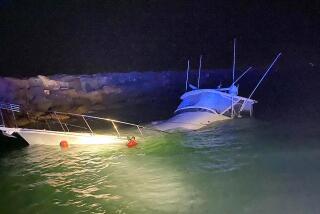Skipper Blamed in Loss of 10 Lives, Boat : Safety Board, Coast Guard Cite Captain in Sinking Off Baja
- Share via
The Coast Guard and National Transportation Safety Board have blamed the captain of a San Diego-based charter boat for the Feb. 5 sinking off Baja California that killed 10 of the 12 people aboard.
“The probable cause of the accident was the failure of the captain to maintain the vessel at a safe distance from an area of large breaking swells in shallow water,” said an NTSB report issued Tuesday.
The only two survivors in the capsizing are passenger James Sims, 29, of Riverside, and crew member Cathy Compton, 38, of San Diego.
Coast Guard spokesman Lt. (j.g.) John Sullivan said the Coast Guard will issue its report Friday, with similar conclusions.
The Coast Guard and NTSB conducted a joint investigation and public hearing on the sinking of the Fish-n-Fool, which occurred after the 57-foot vessel was hit by a rogue 20-foot wave 150 miles southwest of San Diego. Both agencies have pinned responsibility on the dead skipper, Gary LaMont of Spring Valley.
Slow Rescue Not a Factor
The NTSB report, adopted at a meeting of the board Tuesday in Washington concludes that though Coast Guard rescue efforts were slowed by lack of a rescue agreement between the U.S. and Mexican governments, even a faster rescue effort would have been futile.
The report says that contributing to the loss of life was “the inadequate passenger safety briefing and inadequate training of the deckhand” and an ill-fated decision of survivors to abandon the capsized vessel and attempt to swim to San Martin Island more than two miles away.
“The boat did not sink for several hours,” NTSB spokesman Ted Lopatkiewicz said. “There is a rule of the sea: always stay with the boat when it capsizes. The boat will float. The prudent thing is to stick with the boat and not try to swim to an island 2 1/2 miles away.”
Sullivan concurred, noting that rescue gear such as life jackets will often pop out from beneath a capsized boat and can be seized by survivors. “The decision to leave the scene contributed to the loss of life,” he said.
The NTSB recommends that the Coast Guard and Mexican government work out an agreement on when the Coast Guard can venture into Mexican air space or its 12-mile limit in coastal waters to attempt rescues.
In San Diego, Sullivan said he understands those negotiations are already under way between the Mexican government and the U.S. State Department.
Better Training Urged
NTSB also recommends better training for deckhands and stricter requirements that a vessel always be under the control of a licensed operator.
Lopatkiewicz said testimony showed that the Fish-n-Fool was sometimes under the control of an unlicensed deckhand, but it does not appear that was a factor in the sinking.
William P. Barry, the Los Angeles attorney representing Fish-n-Fool Inc., the corporation comprising LaMont and his widow, Inez, declined comment on the NTSB or Coast Guard conclusions until their more detailed reports are issued. Fish-n-Fool Inc. had chartered the vessel from its owner, Bernst Inc.
Carlton E. Russell, the Los Angeles attorney representing the widow of one of the Fish-n-Fool passengers, said he agreed with the the NTSB and Coast Guard conclusions.
Russell has filed suit against Fish-n-Fool Inc., Bernst Inc., and H&M; Sportfishing Landing of Point Loma, one of four civil suits arising from the tragedy.
‘Wrong Place, Wrong Time’
“The vessel was in the wrong place at the wrong time for reasons an experienced mariner would find hard to understand,” Russell said. “An experienced mariner knows not to go near hidden rocks in shallow water when storms are brewing.
“The comment about the deckhand’s inexperience is not unexpected. There was testimony that the deckhand was supposed to be the lookout, and if the skipper had been told in time that a huge wave was coming, he could have moved his nose into it and possibly survived.”
Russell said the investigation reports are not admissible as direct evidence in the damage suits but will probably be admitted when mentioned by expert witnesses. “One way or another, these will be mentioned in court,” he said.
More to Read
Sign up for Essential California
The most important California stories and recommendations in your inbox every morning.
You may occasionally receive promotional content from the Los Angeles Times.










